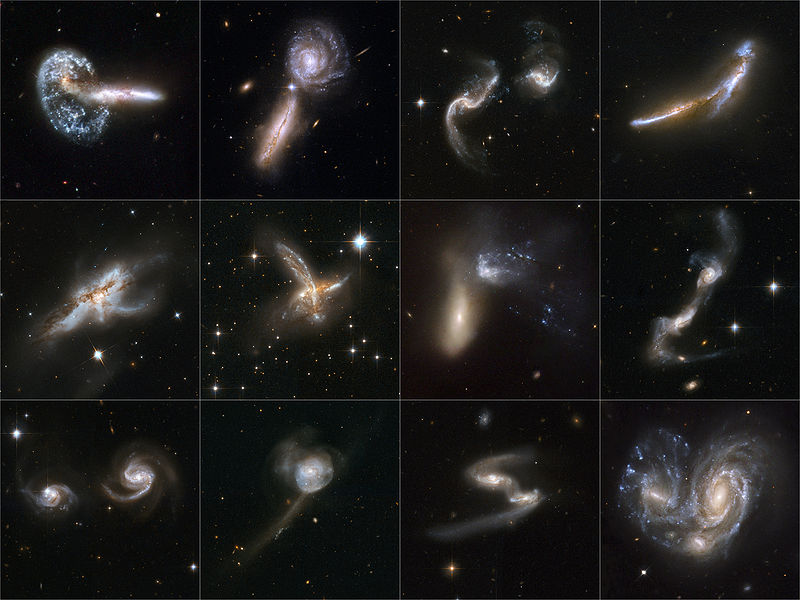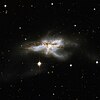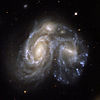Datei:Galaxies Gone Wild!.jpg

Originaldatei (6.000 × 4.500 Pixel, Dateigröße: 17,96 MB, MIME-Typ: image/jpeg)
Diese Datei stammt aus Wikimedia Commons und kann von anderen Projekten verwendet werden. Die Beschreibung von deren Dateibeschreibungsseite wird unten angezeigt.
|

|
Dieses Bild war am 30. Juli 2008 das Bild des Tages. Es hatte die folgende Beschreibung: Deutsch: Mehrere kollidierende Galaxien, aufgenommen vom Hubble-Weltraumteleskop Andere Sprachen:
Bosanski: Slike galaksija koje je načinio Hubble teleskop Deutsch: Mehrere kollidierende Galaxien, aufgenommen vom Hubble-Weltraumteleskop English: Galaxy collision images taken by the Hubble Space Telescope Français : Galaxies en collision, vues par le télescope spatial Hubble Polski: Zdjęcia galaktyk wykonane Kosmicznym Teleskopem Hubble'a. Svenska: En plansch med tolv bilder av kolliderande galaxer. Беларуская: Здымкі галактык, зробленыя касмічным тэлескопам «Хабл». Русский: 12 снимков галактик, сделанные телескопом «Хаббл» Српски / srpski: Галаксије на снимцима, које је направио космички телескоп Хабл. मराठी: हबल स्पेस टेलीस्कोप द्वारा चित्रीत विविध आकाशगंगा. 한국어: 허블 우주 망원경으로 촬영한 은하 사진들. 中文: 哈勃空间望远镜拍摄的星系图集 中文(繁體): 哈柏太空望遠鏡拍攝的12種星系圖集 |

|
This image was selected as picture of the day on Vietnamese Wikipedia.
|
Beschreibung
| BeschreibungGalaxies Gone Wild!.jpg |
English: Original NASA caption reads:
"Astronomy textbooks typically present galaxies as staid, solitary, and majestic island worlds of glittering stars. But galaxies have a wild side. They have flirtatious close encounters that sometimes end in grand mergers and overflowing "maternity wards" of new star birth as the colliding galaxies morph into wondrous new shapes. Today, in celebration of the Hubble Space Telescope's 18th launch anniversary, 59 views of colliding galaxies constitute the largest collection of Hubble images ever released to the public. This new Hubble atlas dramatically illustrates how galaxy collisions produce a remarkable variety of intricate structures in never-before-seen detail. Astronomers observe only one out of a million galaxies in the nearby universe in the act of colliding. However, galaxy mergers were much more common long ago when they were closer together, because the expanding universe was smaller. Astronomers study how gravity choreographs their motions in the game of celestial bumper cars and try to observe them in action. For all their violence, galactic smash-ups take place at a glacial rate by human standards - timescales on the order of several hundred million years. The images in the Hubble atlas capture snapshots of the various merging galaxies at various stages in their collision. Most of the 59 new Hubble images are part of a large investigation of luminous and ultra- luminous infrared galaxies called the GOALS project (Great Observatories All-sky LIRG Survey). This survey combines observations from Hubble, NASA's Spitzer Space Telescope, NASA's Chandra X-ray Observatory, and NASA's Galaxy Evolution Explorer. The majority of the Hubble observations are led by Aaron S. Evans of the University of Virginia, Charlottesville, the National Radio Astronomy Observatory, and Stony Brook University.
Français : Galaxies en collision, vues par le télescope spatial Hubble.
De telles collisions sont très rares (une galaxie par million), mais elles étaient bien plus fréquentes dans le passé lointain, quand l'univers était plus dense. De telles collisions durent plusieurs centaines de millions d'années, et Hubble en a saisi plusieurs à des stades différents. La majorité de ces observations ont été faites sous le contrôle de Aaron S. Evans de l'Université de Virginie à Charlottesville, aux États-Unis. Українська: Зображення взаємодіючих галактик, отримані космічним телескопом Хаббл. Взаємодіючі галактики це досить рідкісне явище у сьогоднішньому Всесвіті (один випадок на мільйон галактик), хоча для раннього Всесвіту ця ймовірність була більшою, завдяки його більшій густині. Взаємодія (або проникнення галактик одна в одну) розтягується на мільйони років й за допомогою Хаббла людство має можливість відзняти сьогоднішній стан взаємодіючих галактик в деталях. |
||||||||||||||||||||||||
| Datum | |||||||||||||||||||||||||
| Quelle | http://hubblesite.org/newscenter/archive/releases/2008/16/image/a/ (direct link) | ||||||||||||||||||||||||
| Urheber |
NASA, ESA, the Hubble Heritage (STScI/AURA)-ESA/Hubble Collaboration, and A. Evans (University of Virginia, Charlottesville/NRAO/Stony Brook University)
|
||||||||||||||||||||||||
Lizenz
| Public domainPublic domainfalsefalse |
| This file is in the public domain because it was created by NASA and ESA. NASA Hubble material (and ESA Hubble material prior to 2009) is copyright-free and may be freely used as in the public domain without fee, on the condition that only NASA, STScI, and/or ESA is credited as the source of the material. This license does not apply if ESA material created after 2008 or source material from other organizations is in use. The material was created for NASA by Space Telescope Science Institute under Contract NAS5-26555, or for ESA by the Hubble European Space Agency Information Centre. Copyright statement at hubblesite.org or 2008 copyright statement at spacetelescope.org. For material created by the European Space Agency on the spacetelescope.org site since 2009, use the {{ESA-Hubble}} tag. |
Kurzbeschreibungen
In dieser Datei abgebildete Objekte
Motiv
24. April 2008
Dateiversionen
Klicke auf einen Zeitpunkt, um diese Version zu laden.
| Version vom | Vorschaubild | Maße | Benutzer | Kommentar | |
|---|---|---|---|---|---|
| aktuell | 19:38, 24. Apr. 2008 |  | 6.000 × 4.500 (17,96 MB) | wikimediacommons>とある白い猫 | {{Information |Description=Astronomy textbooks typically present galaxies as staid, solitary, and majestic island worlds of glittering stars. But galaxies have a wild side. They have flirtatious close encounters that sometimes end in grand mergers and ov |
Dateiverwendung
Die folgende Seite verwendet diese Datei:
Metadaten
Diese Datei enthält weitere Informationen, die in der Regel von der Digitalkamera oder dem verwendeten Scanner stammen. Durch nachträgliche Bearbeitung der Originaldatei können einige Details verändert worden sein.
| Kameraausrichtung | Normal |
|---|---|
| Horizontale Auflösung | 300 dpi |
| Vertikale Auflösung | 300 dpi |
| Software | Adobe Photoshop CS3 Macintosh |
| Speicherzeitpunkt | 14:39, 22. Apr. 2008 |
| Farbraum | Nicht kalibriert |












